Desert plants have an inherent powdery hydrophobic coating on their leaves. In this video on the left side of the leaf you can see the coating has been tarnished with a fingerprint. As a result water accumulates in this area as opposed to rolling directly off like the rest of the leaf.
Once tasked with capturing an interesting fluid phenomenon, I decided to think about how I could match this request with my passion for plants. Eventually, I remembered that water just seemed to run off certain plants as if it were a marble rolling on a wood floor. I knew that these plants had a hydrophobic coating which made this phenomenon possible. Barthlott et al. estimates that superhydrophobic plant leaves are abundant enough that their surface area could cover about 50% of the planet (Barthlott, Matthias , Bharat, & Kerstin , 2017). I intended to create a tranquil video that would highlight this wonder that is often overlooked.
Super hydrophobia can be differentiated from hydrophobia using the angle between the side of the water droplet and the contact surface known as the contact angle (Figure 1). If the contact angle is less than 90° it is hydrophilic (water loving), if it is between 90° and 150° it is hydrophobic, and if it has a contact angle larger than 150° it is superhydrophobic (Bhatia, 2014).
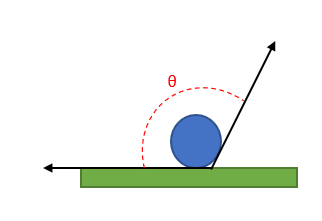
Figure 1: If θ is larger than 150° than the surface is superhydrophobic.
A superhydrophobic surface may look like teeth of a comb that were covered in wax (Figure 2) depending on the type of plant and epicuticular wax. Because the droplet is not contacting the leaf at every point there is less surface area to be tugged on. In fact, scientists at the Los Alamos Neutron Science Center used neutron reflectometry to prove that water actually hovers above the hydrophobic surface on a thin, low-density water layer about a nanometer in thickness (Doshi, Erik, Jacob, & Jaroslaw, 2006).
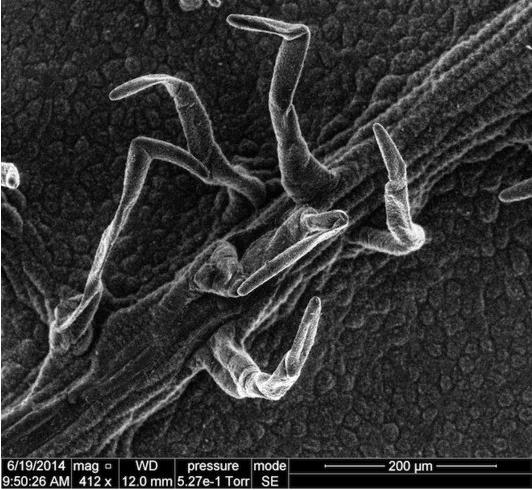
Figure 2: Surface of Macleaya Cordata (plume poppy) under intense magnification (Bhatia, 2014) exemplifying the minimal surface area a water droplet would sit upon.
My “Get Wet” video features my Mangave plant which is a hybrid between a Manfreda and an Agave. This plant develops an epicuticular wax or farina as each new leaf unfurls. This wax gives each leaf its almost dusty-looking appearance. The wax sits on top of the plant’s cuticles and mainly acts as a barrier against uncontrolled water loss through transpiration. The farina may also function to protect the plants DNA through absorption, scattering, and reflection of UV and visible light at the cuticle interface (Koch & Hans-Jurgen , 2008).
The Mangave plant captured in the video sat in the lowest tray of my grow shelf under two 54W lights while the camera shot from above as it sat on a chair and stack of printer paper (Figure 3). Water was dispensed downward from a 25-fluid oz. spray bottle onto the leaf in focus in the video. The leaf was 1.2” across.
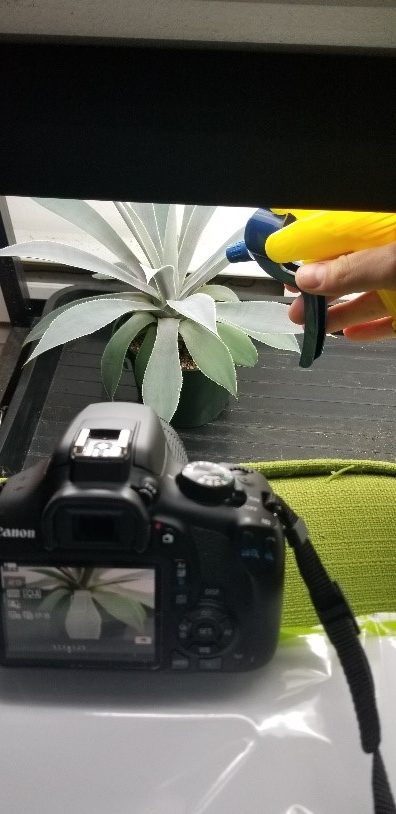
Figure 3: Experimental setup including camera, mangave plant, and spray bottle.
When reviewing the video, one can note how the phenomenon is different over different sections of the leaf as seen in Figure 4.
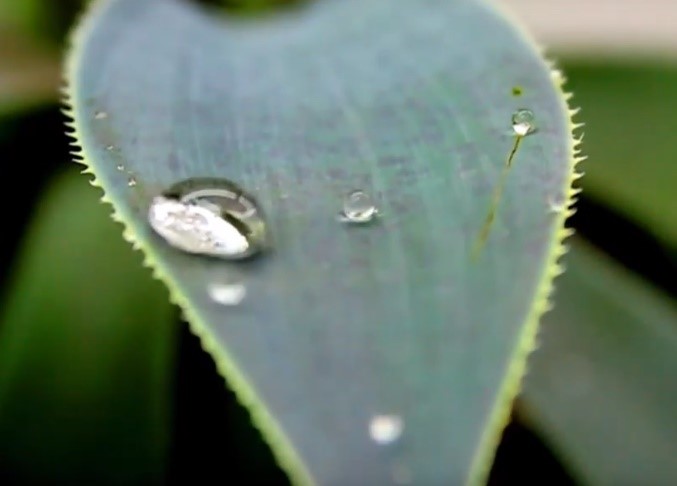
Figure 4: Fluid phenomenon captured across three regions of the leaf.
The water conglomerated on the left side of the leaf where the coating had been disturbed until the weight of the water exceeded the leaf’s ability to support the load. As a result, the leaf would bend downward increasing the angle (θ) which caused the x component of the weight force to exceed the magnitude of the friction force in the -x direction causing a net force in the +x direction (Figure 5).
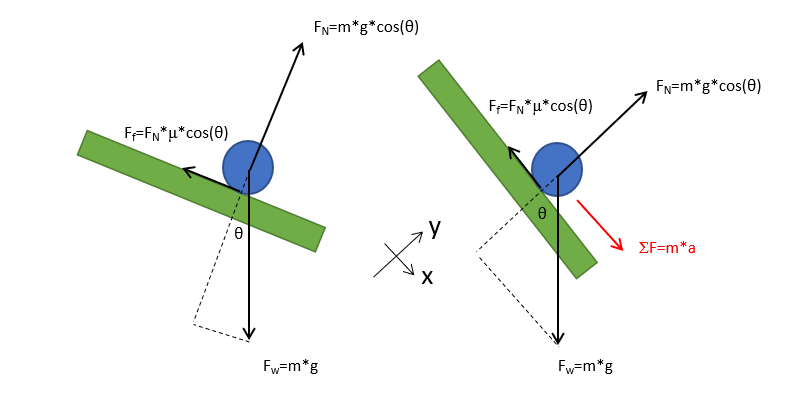
Figure 5: Free body diagram of the water before and after bending the leaf.
The water in the middle of the leaf would roll over the left side of the leaf or down toward the crown of the plant depending on the direction of momentum it gained as it was launched from the spray bottle. The events occurring in the middle of the leaf are the best depiction of super hydrophobia as the droplets appear to be almost perfectly spherical.
The water resting in the wound on the right side of the plant exhibited a mix of behavior listed above: the water droplet would accumulate water until the forces of gravity pulled it toward the center of the leaf (Figure 5) or if other droplets would contact it with enough force, the droplet would bounce off of the gouge as if a rubber ball hitting the pavement and deflecting away.
I wanted to focus on one leaf in order to really direct viewer attention on the phenomenon. At the same time, I wanted to provide the rest of the plant in the background as a way to give context to the situation and a vague understanding of the structure of the plant. I chose a distance away from the plant that allowed me to only provide a crisp image where the water was striking the leaf in hopes of concentrating attention on the interaction. The Cannon EOS Rebel T6 used a lens with a focal length of 18-55mm and an aperture of 1:3.5-5.6. The video was shot at 60 frames per second and slowed down to 40% speed. The saturation was set to 90, the contrast set to 100, and the brightness set to -27 in post processing done in Filmora9.
Overall, I believe my video accomplished what I intended. It was paired with lovely relaxing hang drum music by Aaron Ximm which I think really added the tranquility that I was looking for. I love the colors seen in the plant, I think that the purples, yellows, and greens pair very nicely with the white background. I think the post processing contrast really helps to focus the viewer. If given the opportunity, I would film this again using a higher speed camera so that I could slow down the motion even further without losing any continuity. I greatly appreciate however that the camera used was able to pick up slight glimpses of the underlying fingerprint in the left side of the leaf (0:26-0:37). I think it would be fascinating to collect the epicuticular wax and then run experiments to find the minimum angle needed to make the water roll. Also fascinating would be to film the same phenomenon over different plants as they each have their own unique farina structure and to compare the flows. Lastly, I would love to take photos similar to Figure 2 with a droplet of water actually sitting on the structure.
References
Barthlott, W., Matthias , M., Bharat, B., & Kerstin , K. (2017). Plant Surfaces: Structures and Functions for Biomimetic Innovations. Nano-Micro Letters.
Bhatia, A. (2014, 06 24). The Amazing Micro-Engineered, Water-Repelling Surface That Lives Outside My Window. Retrieved from Wired Science: https://www.wired.com/2014/06/empzeal-superhydrophobic-leaf/</p>
Doshi, D. A., Erik, B. W., Jacob, N. I., & Jaroslaw, M. (2006). The Hydrophobic Effect Why Do Raindrops Slide off Leaves? Los Alamos Science, 164-165.
Koch, K., & Hans-Jurgen , E. (2008). The hydrophobic coatings of plant surfaces: Epicuticular wax crystals and their morphologies, crystallinity and molecular self-assembly. Micron, 759-772.

35 Comments. Leave new
I love the fact that you used a real plant leaf for this project. There’s plenty of great flow in nature that can sometimes be overlooked.
Great video, I really enjoyed the focus you had on the large leaf. You were able to demonstrate the hydrophobic effect of the plant really well and the music was also an appealing addition to the video, it created a very serene atmosphere.
Excellent choice of music, and I really appreciate the contrast in focus between the leaf of interest and the leaves in the background. As for video length, it feels a bit long if it’s just meant as a quick demo (30 seconds max might be better). But as a relaxing video to watch for leisure, you could easily go much longer.
I found this video and the music incredibly relaxing. I definitely felt like this imagery presented an incredibly calming way to learn about hydrophobia.
This is so fascinating! I’ve always wondered why the leaves of this kind are so powdery. Love the music choice. The video makes me think of a very serene scene with lush green plants and rain. I’m very impressed with the video quality. This video does an excellent job of demonstrating the effect of hydrophobic surfaces.
The video has a satisfaction sensation after watching it. I really like the editing of the video and the cool hydrophobic effects on plants.
The hydrophobia of the leaf is satisfying and really interesting. It seems as if the droplets want to run away from the leaf
Great job! This is my favorite project so far. My senior project had to do with hydrophobic surface testing and this video would have been great to demonstrate hydrophobic surfaces to the general public.
This is really peaceful. Hrydrophobic coating is such a great idea to capture in motion.
I love the meditative feeling the video has.
I think a video was a great choice for demonstrating what you wanted to show. The music complimented the visuals very nicely and overall it was very calm and serene to watch
This is one of my favorite Get Wet submissions. It looks like your dropping solid spheres of glass on the leaf, not water. The lighting, focus, coloring, and music make this video very calming but interesting. This video also evokes questions of meaning: what is the biological benefit of hydrophobic leaves? Great work!
I liked seeing the one spot that was damaged compared to the rest of the hydrophobic leaf
I like how this video evokes a sense of calmness
Such a great video showing this phenomenon. The focus & quality are super clear! Great job!
The music mixed with the evenness of the water droplet spheres was so peaceful. I can watch this video all day.
I really enjoy the use of the hydrophobic surface and the description of the powdered surface. Very relaxing meditation vibes coming from the video. Would you consider using a number of different leaves to video instead of just one?
This video is very clear. Slowing down the video allows for good visibility of the phenomena.
This is the coolest plant ever. Also the choice of music is great, it gives a relaxing feel.
The video did not look like it’s been slowed down and I liked that. You did a great job for the set up.
This is a really well made video! From the cool phenomenon to the amazing editing with the music. This is so relaxing and peaceful. Good job Jamie.
I liked the presentation and the demonstration of the surface tension effects of the water. Also great job with the video and good music choice. It felt peaceful.
Amazing video, my favorite part was how clear the reflection in the large drop was right before it slipped off the plant.
Do any of your other plants have this same kind of effect? Might be fun to do a comparison video/photo of the different plants reacting to water droplets. I love the music you used, it makes it feel like a meditation video which is very cool. Where did you find the music for the video?
How many times did you have to perform this experiment before you were content with the footage?
I love that you brought the leaf into class so we could see it! You were able to capture a very cool phenomenon with a great focus and I enjoyed the music.
Fantastic job on the focus on the video, it allows us to focus on the droplets which themselves are aesthetically pleasing.
Wow! Great shooting angle. I love the clear reflection on the big drop of water.
Great job in showing off surface tensions. It was really soothing and cool to watch. I loved that large droplet that got knocked off at the end.
I really liked how you were able to keep that one large droplet on the leaf for most of the video, it added a nice consistency that enhanced the hydrophobic effects of the other droplets as they fell off!
It was really interesting to see the parts of the leaf that did not have the hydrophobic coating as well!
I like how you had a spot with a fingerprint to show how that can impact the water’s ability to bounce off the leaf.
Nice job demonstrating the surface tension effects of the water, also great lighting and focus on the subject.
Very cool video, super interesting phenomenon and you capture the hydrophobic nature of the plant about as well as anybody possibly could. The music goes with it really well, too.
This is such a cool phenomenon! Really awesome focusing and composition. My only comment is that I think the video is too long for the same thing happening over and over. I would love to see a high-speed picture of this in action too!